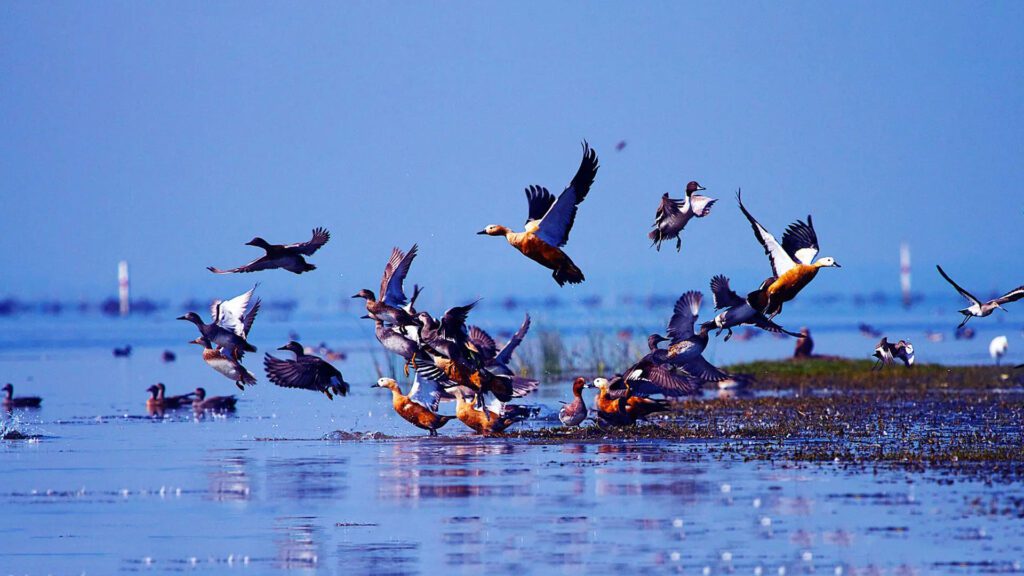Nestled on the northern banks of Chilika Lake – Asia’s largest brackish water lagoon, lies a bird watcher’s paradise – the Mangalajodi Bird Sanctuary. This small wetland is located in the Khordha district of Odisha and is an integral part of Chilika Lake. Covering an area of around 67 hectares, Mangalajodi is known for the thousands of migratory birds that flock here each year, making it one of Asia’s largest wintering grounds. The biodiverse sanctuary is home to over 160 species of birds, both migratory and resident. From Grey Pelicans, Painted Storks, and Bar-headed Geese to Spot-billed Pelicans, the wetlands burst into life during winter. Mangalajodi’s inspiring conservation story transformed the area from a poacher’s den to a thriving eco-tourism destination.

Key Highlights of Mangalajodi Bird Sanctuary
Mangalajodi Bird Sanctuary harbors a wide variety of birds throughout the year. During the winter months of October to March, it receives thousands of migratory birds from Northern Asia, Siberia, Central Asia, and Eastern Europe. Some key species spotted here include Northern Pintails, Common Teals, Ruddy Shelducks, Gadwalls, Spot-billed Pelicans, Lesser Whistling-ducks, and Eurasian Wigeons. Apart from birds, the sanctuary is also home to Fishing Cats, Jackals, King Cobras, and Estuarine Crocodiles. The wetland ecosystem comprises aquatic vegetation like reeds, sedges as well as Mangroves.

This small sanctuary holds great importance as one of Asia’s largest wintering grounds for migratory birds. At its peak during winter, it shelters over 200,000 birds of various species. Bird-watching enthusiasts throng here mainly during winter to catch sight of the winged visitors flocking in from their northern breeding grounds. Conservation efforts of locals have transformed Mangalajodi from a former poaching hub to a haven for wildlife.
Exploring the Sanctuary
The sanctuary can be entered through two gates, one located at Mangalajodi village and the other at Peermuda village. Walking trails wind through the wetlands allowing you to explore the sanctuary on foot. Watchtowers at strategic spots give vantage views for bird watching. Boat rides are available to watch birds from close quarters and spend a day spotting winged wonders amidst the water channels and reed beds.
The Mangalajodi village offers a chance to interact with the local community and learn about their efforts to protect the birds. The wetland area can be further explored via country boats while staying respectful of the wildlife. Nearby attractions around Chilika Lake include Nalabana Bird Sanctuary which harbors thousands of migratory birds in the lake’s 15,200-hectare area.
Activities at Mangalajodi Sanctuary
The primary activity at Mangalajodi is bird watching. Equipped with binoculars, one can spend hours spotting birds hidden amidst the reeds and marshes. Photography enthusiasts will be delighted to capture these feathery visitors in their natural habitat. Slow nature walks are another wonderful way to observe the wetland ecosystem. For the more adventurous, boating excursions provide close encounters with the bird species.
You can also gain insights into the extraordinary conservation efforts of the local fishermen community who gave up their hunting traditions to become the protectors of these birds. Interacting with them educates you on their work and raises awareness about preserving these sensitive wetlands.
Conservation Significance
Mangalajodi faced many threats like habitat loss, pollution, and rampant poaching which had led to a major decline in bird populations. Since the mid-90s, active efforts by the local community have helped safeguard the wetlands. They gave up wildfowling and became dedicated to conservation. Numerous restoration activities like building artificial nests and planting aquatic vegetation brought the migratory birds back.
Today, it stands as a shining example of successful community-based conservation. The Mangalajodi Ecotourism Trust continues to spearhead sustainability initiatives involving locals, conservationists, and the government to protect this land. They also promote eco-tourism to generate livelihood opportunities for the villagers.
Mangalajodi Bird Sanctuary is an ecological treasure trove that shelters thousands of endangered birds each year. It is a testament to the power of community-led conservation. Its wetland ecosystem supports rich biodiversity and provides a safe wintering ground for many migratory birds. Visiting Mangalajodi gives you a chance to admire Odisha’s natural heritage while also contributing to the conservation efforts to protect this important bird habitat.
Destination Attractions, Destination Facilities, Transportation, Accessibility, How to Reach
Temple Open Timings
Mangalajodi Bird Sanctuary Opening Time is Everyday Morning 6 am to Evening 5 pm
Best Time to visit
The best time to visit Mangalajodi Sanctuary is all time of the year and Durgapuja
Closest Bus Stop
The Closest Bus stop is Tangi, which is located around 7 KM distance from Mangalajodi Sanctuary
ClosestRailway Station
The Closest Railway Station is Mukteswar PH, which is located around 3 KM distance from Mangalajodi Sanctuary
ClosestAirport
The Closest Airport is Biju Patnaik International Airport, Bhubaneswar, which is located around 70 KM distance from Mangalajodi Sanctuary





